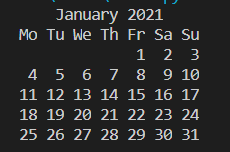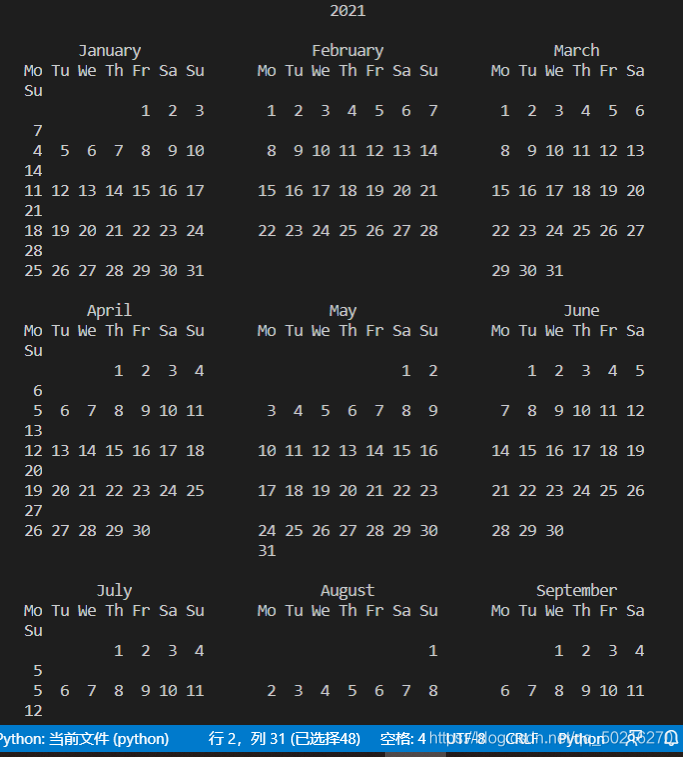終了し、更新を続けるように努めます
記事ディレクトリ
-
- 一.sys
- Os .os
- Three.math
- Four.random
- ファイブタイム
-
-
-
- 1.時間関数は、現在のタイムスタンプ(グリニッジ標準時からの合計秒数)を返すために使用されます。
- 2. localtime関数は、タイムスタンプ形式を現地時間に変換して(struct_time)オブジェクトを返すために使用されます。
- 3. mktime関数はstruct_timeを受け取り、時間を秒単位で表す浮動小数点数を返します。
- 4. gmtime関数は、タイムスタンプを0タイムゾーンのstruct_timeに変換できます。
- 5. asctime関数は、struct_timeを受け取り、読み取り可能な時間フォームを返すことができます。
- 6. ctime関数は、タイムスタンプを読み取り可能な形式に変換できます
- 7.スリープ関数は、呼び出し元のスレッドの実行を遅らせます。パラメーターは秒です。
- 8. strftime関数は時間タプルを受け取り、読み取り可能な現地時間を返します
- 9. strptime関数は、時間文字を時間タプルに解析できます
-
-
- Six.datetime
- Seven.calendar
-
-
-
- 1.calendar.isleapは、うるう年を判断するために使用されます
- 2.canlender.leapdaysは、2年間のうるう年の合計数を返すために使用されます
- 3.canlender.monthメソッドを使用してカレンダーを作成します
- 4. calendar.monthcalenderメソッドは、単一レベルのネストされたリストを返し、各リストには1週間が含まれます
- 5. calendar.monthrangeメソッドは、2つの整数のタプルを返します。最初の数値は月の最初の日の曜日を示し、2番目の数値は月を変更する日数を示します。
- 6.calendar.weekdayメソッドは、指定された日付の週コードを返します
- 7.calendar.calendarは、年間カレンダー全体を返します
-
-
一.sys
1.オペレーティングシステムを特定します
import sys
print(sys.pltfrom)
Os .os
Three.math
Four.random
ファイブタイム
1.時間関数は、現在のタイムスタンプ(グリニッジ標準時からの合計秒数)を返すために使用されます。
import time
now=time.time()
print(now)
1611303060.773287
2. localtime関数は、タイムスタンプ形式を現地時間に変換して(struct_time)オブジェクトを返すために使用されます。
import time
now=time.localtime()
print(now)
time.struct_time(tm_year = 2021、tm_mon = 1、tm_mday = 22、tm_hour = 16、tm_min = 14、tm_sec = 30、tm_wday = 4、tm_yday = 22、tm_isdst = 0)
3. mktime関数はstruct_timeを受け取り、時間を秒単位で表す浮動小数点数を返します。
import time
now=time.localtime()
print(now)
s=time.mktime(now)
print(s)
time.struct_time(tm_year = 2021、tm_mon = 1、tm_mday = 22、tm_hour = 16、tm_min = 21、tm_sec = 1、tm_wday = 4、tm_yday = 22、tm_isdst = 0)
1611303661.0
4. gmtime関数は、タイムスタンプを0タイムゾーンのstruct_timeに変換できます。
import time
now=time.time()
print(now)
s=time.gmtime(now)
print(s)
1611303823.960081
time.struct_time(tm_year = 2021、tm_mon = 1、tm_mday = 22、tm_hour = 8、tm_min = 23、tm_sec = 43、tm_wday = 4、tm_yday = 22、tm_isdst = 0)
5. asctime関数は、struct_timeを受け取り、読み取り可能な時間フォームを返すことができます。
import time
now=time.time()
print(now)
s=time.gmtime(now)
print(s)
new=time.asctime(s)
print(new)
1611303959.5288363
time.struct_time(tm_year = 2021、tm_mon = 1、tm_mday = 22、tm_hour = 8、tm_min = 25、tm_sec = 59、tm_wday = 4、tm_yday = 22、tm_isdst = 0)
金1月22日08:25:59 2021
6. ctime関数は、タイムスタンプを読み取り可能な形式に変換できます
import time
now=time.time()
print(now)
s=time.ctime(now)
print(s)
1611304057.0304146
金1月22日16:27:372201
7.スリープ関数は、呼び出し元のスレッドの実行を遅らせます。パラメーターは秒です。
import time
print("start:",time.ctime())
time.sleep(9)
print("end:",time.ctime())
開始:金1月22日16:29:58 2021
終了:金1月22日16:30:072021
8. strftime関数は時間タプルを受け取り、読み取り可能な現地時間を返します
9. strptime関数は、時間文字を時間タプルに解析できます
Six.datetime
1.日付オブジェクト
import datetime
print(datetime.MAXYEAR) #支持的最大年份
print(datetime.MINYEAR) #支持的最小年份
print(datetime.date.today()) #today返回当天日期
print(datetime.date.today().weekday()) #weekday放回当天的星期
print(datetime.date.today().isoformat()) #返回IOS格式
9999
1
2021-01-22
4
2021-01-22
2.時間オブジェクト
import datetime
print(datetime.time()) #默认时间
print(datetime.time.max) #支持的最大时间
print(datetime.time.min) #支持的最小时间
00:00:00
23:59:59.999999
00:00:00
3.datetimeオブジェクト
datetime = date + time、日付と時刻の両方を返します
import datetime
today=datetime.datetime.today()
print(today)
print(datetime.datetime.now()) #与today用法相同
print(datetime.datetime.utcnow()) #0时区时间
now=datetime.datetime.now()
print(now.date()) #date对象返回日期
print(now.time()) #time对象返回时间
2021-01-22 18:22:42.380595
2021-01-22 18:22:42.382589
2021-01-22 10:22:42.382589
2021-01-22
18:22:42.382589
4.timedeltaオブジェクト
時差を表します
import datetime
dt1=datetime.datetime.now()
dt2=datetime.timedelta(weeks=2)+dt1
print(dt1)
print(dt2)
print(dt1-dt2)
2021-01-22 18:34:31.429461
2021-02-05 18:34:31.429461-14
日、0 :00 :00
5.tzinfoオブジェクト
Seven.calendar
1.calendar.isleapは、うるう年を判断するために使用されます
import calendar
print(calendar.isleap(2000))
print(calendar.isleap(2018))
真
偽
2.canlender.leapdaysは、2年間のうるう年の合計数を返すために使用されます
import calendar
print(calendar.leapdays(1900,2000))
24
3.canlender.monthメソッドを使用してカレンダーを作成します
4つのパラメーター:年、月、w(文字間隔)、l(行間隔)
import calendar
print(calendar.month(2021,1))

4. calendar.monthcalenderメソッドは、単一レベルのネストされたリストを返し、各リストには1週間が含まれます
import calendar
print(calendar.monthcalendar(2021,1))
[[0、0、0、0、1、2、3]、[4、5、6、7、8、9、10]、[11、12、13、14、15、16、17]、[ 18、19、20、21、22、23、24]、[25、26、27、28、29、30、31]]
5. calendar.monthrangeメソッドは、2つの整数のタプルを返します。最初の数値は月の最初の日の曜日を示し、2番目の数値は月を変更する日数を示します。
import calendar
print(calendar.monthrange(2021,1))
(4、31)
6.calendar.weekdayメソッドは、指定された日付の週コードを返します
import calendar
print(calendar.weekday(2021,1,1))
4
7.calendar.calendarは、年間カレンダー全体を返します
import calendar
print(calendar.calendar(2021))
